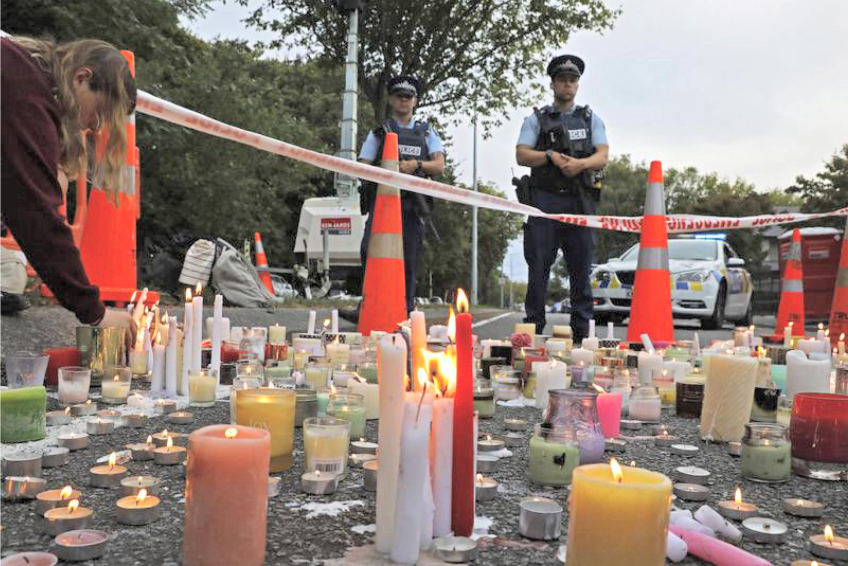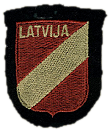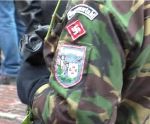The following opinion piece appeared in the Chronicle Herald, a Halifax, Nova Scotia-based web-based news publication. It is representative of fact-challenged calls coming out of Canada to condemn Latvian commemoration of the Latvian Legion.
ON TARGET: Terrorists come in all colours, from all walks of life

On March 16, Canadians were still coming to grips with the shocking news of a terrorist attack in Christchurch, New Zealand. A white supremacist had gunned down 100 Muslims — 50 killed and 50 wounded — at two separate mosques during Friday prayers.
The extremist responsible for this massacre — and like New Zealand Prime Minister Janica Ardern, I refuse to grant him the notoriety he craves by naming him here — published a 74-page manifesto outlining his right-wing racist views.
The international community was quick to condemn this slaughter of innocents as an act of terrorism. This monstrous act also served to highlight the 1growing threat stemming from the rise in alt-right, neo-Nazi and anti-Semitic groups around the world.
The Christchurch terrorist himself made a direct link to Canada by lionizing the Quebec City mosque murder rampage conducted by 28-year-old Alexandre Bissonnette on Jan. 29, 2017.
It was indeed a sobering reminder that terrorists come in all colours and from all walks of life.
In stark contrast to this grim reality, 2mere hours after the Christchurch shootings, more than 1,000 people marched through the streets of Riga, Latvia, to commemorate Hitler’s Second World War SS Latvian Legion.
3This controversial annual parade to celebrate perpetrators of the Holocaust has taken place since 1990, when Latvia gained independence from the Soviet Union. In 1998, this event was declared an official day of remembrance by the Latvian government.
Not surprisingly, such a blatant glorification of Nazis drew a stern rebuke from the European Union. In 2000, the SS Latvian Legion parades were once again made “unofficial.”
Nevertheless, they are allowed to continue. Photographs and videos from this year’s parade — one of the biggest in recent history — 4show several marchers sporting swastikas on their arms.
Diehard Latvian nationalists who defend these parades claim that these swastikas are in fact the cross of thunder, an ancient central Asian symbol. 5Nice try. Since the Second World War and the adoption of the swastika by Hitler’s Nazis, we all know what this symbol has come to stand for.
Many SS 6Latvian Legion apologists argue that this particular military unit was not directly involved in Hitler’s final solution to exterminate the Jews.
This is a bit of a moot point, as 727,000 Jews in Latvia were slaughtered in 1941 and 1942 by a Latvian militia known as the Arajs Kommando.
8By the time SS leader Heinrich Himmler formed the SS Latvian Legion in 1943, Latvia had been proclaimed “Juden Frei” or “free of Jews” by Hitler’s Third Reich.
9The central core of the new SS Latvian Legion was none other than the killers of the Arajs Kommando. That Kommando included a bloodthirsty anti-Semitic officer named Herberts Cukurs, whom Holocaust survivors directly link to the murder of Jews.
Latvian supporters of the SS Legion make the point that many members of these two combat divisions — 120,000 personnel in total — were forcibly conscripted by the Germans. That is a historical fact, which is not in dispute.
However, 10I will argue that if you were forced to wear an SS uniform against your will during the Second World War, it is unlikely that you would dig it out of your closet to proudly wear it down the streets of Riga 45 years later.
No, those SS Latvian Legion veterans who participate in the parades in ever-dwindling numbers were the 11hardcore SS volunteers.
One argument offered by Latvia’s apologists for their glorification of a Nazi unit is that it is a commemoration of the sacrifice they made. 12The problem with that logic is that Nov. 11 remains the official national day of remembrance in Latvia, wherein all fallen warriors are grieved.
Needless to say, B’Nai Brith was never fooled by the obfuscation and distortion of history offered up by those Latvians who have so actively 13sought to rewrite history.
Last July 4, B’Nai Brith Canada wrote an open letter to Prime Minister Justin Trudeau on the eve of his visit to Latvia, urging him to condemn these annual parades.
This sentiment was repeated by a Sun newspaper editorial penned by B’Nai Brith president Micheal Mostyn on March 15, just ahead of this year’s parade.
Well, lo and behold, Global Affairs Canada has now issued a formal condemnation to Latvia.
Canada currently has 540 troops stationed in Latvia, with the stated mission to protect our NATO partner from Russian aggression and to protect our shared values.
14Turns out we don’t share the same viewpoint as Latvia when it comes to glorifying Hitler’s SS. Let’s hope that Canada follows through with the discussions intended to develop what Mills said will be a more “inclusive Latvia.”
It is an unfortunate reality that ultra-nationalism and neo-fascism are on the rise, as is anti-Semitism. Even U.S. President Trump described American neo-Nazis marching and shouting "Jews will not replace us!" as "fine people." The commemoration of the Legion, however, has now taken place for seventy-two years since 1952, and is totally unrelated to current developments.
This is typical of the inflammatory yellow journalism that juxtaposes and associates the annual Legion commemoration with truly heinous hate-based acts. There is not even the remotest connection here.
One has to wonder what Taylor thinks of Latvians, to even suggest that any people would celebrate perpetrators of genocide. Moreover, while open commemoration could take place in Latvia only after the fall of the USSR, the Legion has been commemorated annually since 1952, as already noted. "Controversy" escalated as Russia launched its propaganda campaign against "Latvian fascists" after commemoration of all who died in WWII with the hope of Latvian freedom was made a state holiday in 1998. It further rankled the Kremlin that the same parliamentary act also declared the first Sunday in December a day of commemoration of the victims of Communist genocide.
There is at least one particular individual, well known to regular attendees, who can usually be found standing off somewhere to the side. He is there as a provocation. The media always make sure to feature his swastika and other insignia in their photographs and videos. That may well be that individual we found in a video clip.
It is, in fact, illegal to display Nazi insignia in Latvia.
The swastika was the insignia of the post-WWI Latvian military. The swastika is still used today by Finland's military. The swastika appears in many and ornate variations in Latvian folk costumes and crafts — there is no other culture in which it appears in more variations. One cannot retroactively assign Nazi meaning to a millennia-old cultural symbol based on "what it has come to mean." Hindus aren't retroactive Nazis, either.
There is nothing apologetic about the fact that even Efraim Zuroff, among the most vocal and visible critics of the annual commemoration, acknowledges the Latvian Legion was not involved in the Holocaust. Latvians are not commemorating "the Waffen-SS", they are commemorating the Latvian Legion, and only the Latvian Legion.
Arājs Kommando reported to the Sicherheitsdienst, that is, the arm of the Nazi SS which planned and executed the Holocaust. They numbered 300-500 during the Holocaust in Nazi-occupied Latvia, over 1,000 later in Byelorussia. Their crimes are unrelated to the Latvian Legion.
Taylor admits that the Latvian Legion was created only after the Holocaust had swept through Nazi-occupied Latvia,...
...however, with the Holocaust over, it is a complete lie that Arājs Kommando then formed the core of the Legion. The tragic truth was that Arājs and his men were still murdering Jews in territories south and west of occupied Latvia, primarily Byelorussia. The Legion was created from combat units already serving under the Wehrmacht at the front — none of which were complicit in the Holocaust.
Lastly, deportation trials such as those of Vilis Hāzners prove that multiple eyewitnesses can place individuals where and when they are proven to not have possibly been present. So it is with Cukurs, except Mossad killed him rather than bringing him to trial. Cukurs's case is examined further, below.
Lavian Legion uniforms included Latvian insignia. They did not wear "SS" uniforms. Regardless, it was the only uniform possible in which to combat against the Red Army.
As mentioned, "SD" (Sicherheitsdienst) collaborators were separate from the Legion. There was no Latvian SS. Any of the "hard core" collaborators Taylor speaks of served under the SD as the 100-200 core members of Arājs Kommando, not the Legion.
As mentioned, the Legion commemoration day was originally established in 1952, in the diaspora, as Latvia continued to be occupied by the Soviet Union, to honor the sacrifices of the Legion, particularly those Legionnaires who held out in Courland until the end of WWII, indeed, for an entire week following, petitioning the western Allies for support to reestablish independence.
Just as March 16th pertains to WWII, November 11th pertains to WWI, originally for the annual awarding of the "Order of the Bear-Slayer", later to commemorate all those killed in Latvia's War of Independence.
There is no reason to combine the two.
"Latvians are attempting to rewrite history." The accusation is made, but never explained in specifics. That Latvians did not collaborate in the Holocaust? No, Latvians acknowledge their guilty. That the Latvian Legion/Waffen-SS did not kill Jews? Actually, they did not. That Latvia was not "liberated" by the USSR? Latvians and indeed all the peoples of the nations between Germany and Russia do not consider themselves to have been "liberated" following WWII. The only "rewriting" taking place is tearing down the glorification of Stalin and the "Great Patriotic War."
Ironically, had Stalin not invaded Latvia first, had Stalin not ordered mass deportations just a week prior to the Nazi invasion, had the Nazis been the first invaders, then it would have been the Soviets, not the Nazis, whom Latvians hailed as "liberators," at least at first. Instead, the Nazis were the "liberators" until they proved another brutal occupier.
No one cares to believe Hitler at his word that one of the reasons he decided to invade the USSR was because Stalin overstepped the bounds of "spheres of influence" by invading and annexing the Baltic states and parts of Romania. Russians would protest that to contend so would be "victim blaming" — look how many casualties the Soviet Union suffered. But that would ignore that Stalin and Hitler launched WWII in partnership.
Taylor repeats his baseless conflation of Hitler's criminal SS and the Latvian Waffen-SS. Even Efraim Zuroff acknowledges the Legion were not criminal Holocaust collaborators. Latvian would not glorify the Hitler's criminal SS either — nor do they.
Behind the headline
When the Latvian ambassador debunked Taylor's similar contentions the prior year, Taylor responded:
Scott Taylor replies: The simple response to the allegation I am perpetuating ‘Fake News’ is to remind readers that this moniker does not apply if the facts are true. Every year on 16 March, hundreds of Latvians march through the centre of Riga to commemorate the Waffen SS Latvian Legion. This is not a private ceremony as the Ambassador suggests, but rather a very public expression of support to a military unit that was part of Hitler’s notorious SS killing machine. The Holocaust did not simply ‘happen’ to Latvian jews, it was perpetrated by willing Latvian volunteers such as the ruthless thug Herberts Cukurs and his henchmen in the Arajs Kommandos who prided themselves of making Latvia “Juden Frei” by 1943. That same year Heinrich Himmler formed the Latvian SS Legion and at its core was Cukurs and the Arajs Kommando. To suggest that somehow the Latvian Legion, comprised of these murderers was not directly implicated in the Holocaust is an insult to our collective intelligence. For the Ambassador to claim that the 16 March parade is an expression of Free Speech means there is still a misunderstanding in recently democratized, former Soviet Republic Latvia as to the clear line between Free Speech and Hate Speech. The core of Nazi ideology is rooted in anti-semitic hate. Celebrating it is simply wrong and these parades need to be stopped. For the record, from 1998 until 200 the 16 March parades were in fact official, and again even this year the right wing, Nationalist opposition party tabled a motion to re-instate official status to these ceremonies. If Canada is going to commit troops and money to protect democratic values in Latvia from Russian aggression, we have the right to remind Latvia that celebrating the Holocaust perpetrators is totally counter to our own Canadian set of values.
The Latvian Legion was not "part of Hitler’s notorious SS killing machine." Cukurs, as it turns out, was not the "Butcher of Rīga." Moreover, where Arājs Kommando and other collaborators are concerned, Taylor ignores that the Germans engineered the Holocaust in every detail. Arājs Kommando were certainly the most notorious and murderous of the Nazi's collaborators, but it would be wrong to contend that every one of their actions was not closely managed by their Nazi overlords.
The Latvian Legion was not composed of such "murderers." And, once again, the Legion has been commemorated since 1952. Whether such commemoration is observed officially or not, privately or publicly, inside or outside Latvia, it has no role in furthering anti-Semitic hate or honoring murderers. Taylor's portrayal of the Holocaust in Latvia is an exercise in perpetrator name-dropping wrapped in a flawed historical narrative fed by his clearly evident belief that Latvian Nazis are a clear danger, past and present.
"Ruthless thug" Herberts Cukurs
Cukurs was not an officer leading Arājs Kommando members. Arājs took on Cukurs as his garage supervisor, ironically, to save him from the Nazis. During the Soviet occupation, Cukurs had traveled to Moscow, where he was offered the position to lead a Red Army aviation wing. Cukurs declined. That the Soviets simply didn't kill him for refusing made the Nazis, upon their invasion, suspect Cukurs was a Soviet sympathizer. By taking Cukurs on, Arājs almost certaintly saved his life.
The most well known accusation against Cukurs, that of burning Jews in a Riga synagogue, is a fabrication of Soviet propaganda. Cukurs was not even in Rīga when the massacre took place. Cukurs arrived in Rīga only on July 14th — that alone invalidates witness testimonies purporting to place him at the scenes of most of the atrocities he is accused of./p>
Another well-circulated accusation is that of Max Kaufmann, that Cukurs issued orders to collaborators taking Jews to Rumbula to their doom:
SA [Sturmabteilung, storm troopers] members in their brown uniforms kept arriving continually; among them were Altmeyer and Jäger. The Latvian murderer Cukurs got out of a car wearing a leather coat, with a large pistol (Nahan) at his side. He went to the Latvian guards to give them various instructions. He had certainly been informed in detail about the great catastrophe that awaited us. The guards had been strongly reinforced, and large amounts of schnapps (liquor) had been delivered to them.1
Kaufmann's account here suffers as do all personal accounts by "filling in the blanks" based on personal bias. In truth, Kaufmann has no knowledge of what Cukurs said, and therefore projects his own belief of Latvian hatred of Jews on to Cukurs.
Holocaust scholar Andrew Ezergailis, as many, at first believed Cukurs had been a Holocaust collaborator. On closer investigation in later years after more materials became available, Ezergailis discovered Cukurs was not issuing orders at all. Rather, he was desperately looking for his Jewish mechanic, Lutriņš, who had been swept up in the ranks of those destined to be shot at Rumbula. Lutriņš was found, hidden, and brought back to Cukurs's garage. Cukurs's family also saved Miriam Kaizner, hiding her on their farmstead in Bukaiši, later to take her with them to Brazil; and saved Abram Shapiro by providing working papers in the summer of 1941.
Regarding corroboration of survivor accounts, there is no mention of Cukurs in any of hundreds of trial depositions of former Arājs Kommando members — unlike with other of Arājs's fellow perpetrators. Nor, when Arājs was tried in Hamburg, Germany, was Cukurs ever mentioned anywhere in those documents, either. In short, there is no documentary evidence supporting the contention that Cukurs personally murdered any Jews; moreover, what documentary evidence does exist supports quite the opposite. Ezergailis's inevitable conclusion?
Rather than ask 'how many Jews did Cukurs kill?', ask 'did he even kill one Jew?'.... Sufficient verified documentation now exists to show that in the vast majority of accusations, Cukurs could not have even been present, let alone responsible.
More reading
- MOSSAD Killed an Innocent Man. Prof. Dr. Andrew Ezergailis is the pre-eminent expert on the Holocaust in Latvia.
- For the role of eyewitness accounts and bias in the indictment of Latvians as war criminals, see our analysis of the Hāzners deportation case.
| 1 | Kaufmann, M. and Schneider, G. and Wiehn, E.R.. Churbn Lettland: The Destruction of the Jews of Latvia, Hartung-Gorre, 2010, page 30-31, ISBN: 9783866283152. LINK |

